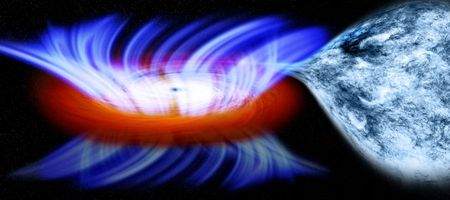A black hole discovered by NASA’s Chandra X-ray Observatory is generating winds blowing at 20 million miles per hour – about three percent of the speed of light.

“This is like the cosmic equivalent of winds from a category five hurricane,” says Ashley King from the University of Michigan. “We weren’t expecting to see such powerful winds from a black hole like this.”
IGR J17091 is a binary system in which a sun-like star orbits the black hole. It’s located in the bulge of the Milky Way galaxy, about 28,000 light years away from Earth.
The wind emanating from it is nearly 10 times faster than has ever been seen before from a stellar-mass black hole, and matches some of the fastest winds generated by supermassive black holes – which can be billions of times more massive.
“It’s a surprise this small black hole is able to muster the wind speeds we typically only see in the giant black holes,” says Jon M Miller, also from the University of Michigan. “In other words, this black hole is performing well above its weight class.”
The team was also surprised to discover that the wind, which comes from a disk of gas surrounding the black hole, may be carrying away more material than the black hole is capturing.
“Contrary to the popular perception of black holes pulling in all of the material that gets close, we estimate up to 95 percent of the matter in the disk around IGR J17091 is expelled by the wind,” says King.
Simultaneous observations made with the National Radio Astronomy Observatory’s Expanded Very Large Array show that there was no radio jet from the black hole when the ultra-fast wind was seen, although one is seen at other times. This agrees with observations of other stellar-mass black holes, and provides further evidence that the production of winds can stifle jets.
A Chandra spectrum of iron ions made two months earlier showed no evidence of the high-speed wind, meaning the wind likely turns on and off over time.
Astronomers believe that magnetic fields in the disks of black holes are responsible for producing both winds and jets. The geometry of the magnetic fields and rate at which material falls towards the black hole must influence whether jets or winds are produced.






